August 2013 – Volume 15, Issue 12:The Magnificent
IN THIS ISSUE
Flanigan’s Eco-Logic
Airborne Wind Turbines
Net Zero Buildings
The Hyperloop
White House Solar
Trash Power

Flanigan’s Eco-Logic: Radiation and Innovation
What is radiation? Why be concerned about the safety of nuclear power? For those of us in Southern California, after the closure of San Onofre Nuclear Power Station, have we nothing to worry about? Are our radioactive concerns over?
The radioactive dangers of nuclear power, unfortunately, are with us throughout the fuel cycle, from mining, refining, shipping, reacting in the plant itself, and handling the wastes for upwards of 10,000 years. We now have 65,000 tonnes of such wastes in temporary storage across the country, not to mention multiples of this in “low-level” radioactive waste. Then there’s the link between civil nuclear power programs and weapons, and terrorism.
At San Onofre, there are 1,400 tons of highly radioactive spent fuel, hundreds of thousands of spent fuel rods, most in water-filled cooling ponds (1,100 tons), that could potentially be affected by a Fukushima-style earthquake/tsunami, or attack and that are within 50 miles of nearly 9 million people. The pools were never designed for such concentrations and long-term storage; federal government plans for permanent solutions – notably Yucca Mountain – have been greatly delayed. The next step for the wastes is dry cask storage.
Radiation is expressed as subatomic particles traveling at or near the speed of light. That’s 186,000 miles per second. In a reactor, this thermal energy drives steam turbines. When humans are exposed to radiation, and if intense enough, it is an ionizing force that can penetrate deep in the body knocking electrons off particles and burning havoc. If the radiation penetrates sex cells, it can cause genetic abnormalities. Bodies fight back, often causing cancers in the process.
Small doses of radiation are natural. Radiation is measured in REMs, Roentgen Equivalent in Man… the smaller the dose the better. (Roentgen discovered the x-ray.) Small doses cause nausea and fatigue (50 REMs), and vomiting (70). Bigger doses cause hair loss, and hemorrhaging (100), and death within months (400) and death within hours or days (2,000). As an employee of New York Power Authority, I remember walking inside the Indian Point 3 nuclear reactor containment vessel years ago, standing casually at the rim of the pool of reactor tubes with my NRC badge measuring REMs.
Is nuclear power dangerous? Good question. Big accidents seem to happen every decade or so, looking back to Three Mile Island (1979), Chernobyl (1986), and Fukushima Daiichi (2011). They were the result of human error, lousy design, and massive natural events. In theory, nuclear reactions can be controlled and safe; in theory wastes can be stored safely too.
The Chernobyl Exclusion Zone, known commonly as “The Zone,” is a 30-kilometer radius from the nuclear plant. Evacuations were ordered, and the area placed under military control. Its borders were later expanded, now an area of 2,600 square kilometers. At Fukushima, there is a 20-kilometer exclusion zone. Imagine drawing such a zone around a nuclear plant near you, and removing all the people, businesses, schools… everything, for perhaps a century or more.
So this issue focuses on “the magnificent,” a series of projects that have caught my eye recently and that certainly challenge the need for an “all of the above” national energy strategy. This smattering of technologies, and the boundless ingenuity that they represent, buries the concept of taking life-threatening risks to generate power.
This EcoNet News issue features the magnificent… from airborne wind turbines, to net positive waste gasification, Elon Musk’s proposed Hyperloop, the net zero building movement, and the White House going solar once more. What a wonderful world, and one in which the perils of radiation need not be considered and weighed in statistical probabilities.
Airborne Wind Turbines

Makani’s turbine spins in large circles in the sky
Imagine tethering a small plane like device at 800 feet. At that point, and perhaps like a kite, the device begins to spin in a huge loop, powered by the wind, generating power which is then shunted down to terra firma. Crazy concept, funded, and being tested. Makani, a leading developer, acquired by Google.
I shoot directly to the website FAQ: What about aviation? Sounds like planes could get snarled in the lines. Answer: the AWTs are deployed at less than 1,000 feet, below flight traffic. And when there’s no wind, they can either be powered to maintain their orbits, or they can be “landed” and then automatically “re-flown” when the wind picks up.
AWTs take advantage of the wind resource: There is higher velocity wind and almost constant wind at altitudes that can’t be reached with conventional turbine towers. That’s the upside. Then three key challenges: Suspending and maintaining turbines at hundreds of meters off the ground in high winds and storms, transferring the power generated back to earth, and, yes, interference with aviation.
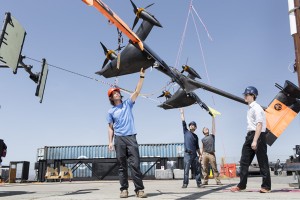
Prepping Makani’s M30 turbine
There are a number of AWT systems. Aerostat-type wind systems involve buoyancy to support the wind turbines. Balloons have been considered to keep generators aloft; sun-heated balloons may solve the helium leakage problem. A 35-foot test of a 2.5 kW Skystream wind turbine was done in 2012. Another system uses two helium balloons that alternative positions and generate electricity in the process. And as for transferring the power generation back to earth, long power cords are the preferred choice, but lasers and microwaves are considered.
The Makani system is “a tethered, autonomous wing fitted with onboard turbines for power generation.” Put another way, it is a lightening-hardened, kite-powered system that its developers claim can produce power at half the cost of conventional wind by increasing the wind capacity factor from 25% to 60%, using 90% less material than conventional turbines, and deploying in large, open, and otherwise unusable places.
Makani’s M30 is a 30 kW unit with an 8 meter wing. Makani’s planned 5 megawatt wing would be 65 meters wide. This past May 9th, Makani successfully conducted its first test flight. Stay tuned, and tethered!
Net Zero Energy Buildings
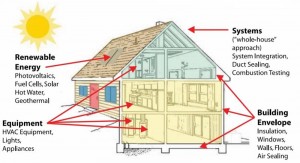 One of California’s big and bold energy strategies is the promotion of net zero energy buildings. By 2020, the State will require that all new residential construction is net zero. By 2030 all new commercial buildings in the State will be required to be net zero. The federal government has even broader goals… for 50% of the building stock to be net zero by 2040, 100% by 2050.
One of California’s big and bold energy strategies is the promotion of net zero energy buildings. By 2020, the State will require that all new residential construction is net zero. By 2030 all new commercial buildings in the State will be required to be net zero. The federal government has even broader goals… for 50% of the building stock to be net zero by 2040, 100% by 2050.
The United States currently has 275 billion square feet of commercial building space. About 1.75 billion square feet is demolished each year, while 5 billion is renovated, and there is 5 billion of new construction each year. This constitutes 10 billion square feet of new and refurbished space annually, such that by 2035 about three-quarters of all buildings will be new or renovated. They should be ZEC… or net “zero energy capable,” meaning that the building owners should have implemented full sets of robust energy efficiency measures so that their buildings are now are capable of achieving a net zero status through investments in renewable energy, be they solar, wind, geothermal, or in combination.
Net zero has several definitions and regulations and their requirements are not yet finalized. Does every building need to generate its own energy on-site? Can it be located off-site? Does a renewable system in a net zero building cover both electric and thermal needs, for instance both electricity and gas use and the overall energy use intensity? What about the upstream losses in electrical systems – transmission and distribution losses? Do these need to be factored into the offset equation? How about EVs? If a home has an EV, does its renewable energy system need to cover that too? Inversely, does a home or commercial property get credit bicycle parking – that offsets conventional transportation use – and infill development? Can a building purchase RECs, renewable energy credits? What about the embedded energy of produces purchased in the home, or food consumed? Answers to come.
We’ve reported on the wild card in the NZE movement: occupant behavior. While a building may be designed to be net zero, what if the building experiences unusually high occupancy? What if users are just plain energy intensive… beyond design expectations? Will buildings be required to be certified a) at time of sale, and b) annually or periodically for their life? These are among the policy decisions key to this movement.
Case studies are flowing in. Exciting is the fact that net zero energy buildings are being built, and often at market rates. Ideally, they’re about smart design, ending up with operating costs that are a fraction of their conventional, code-compliant brethren. Often, they are more enlightened spaces and more comfortable, with radiant heat and under-floor air distribution.
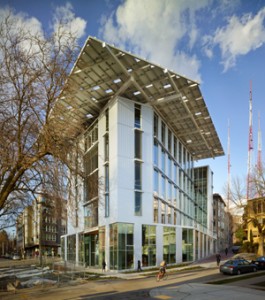
Bullitt Center in Seattle, WA
The New Buildings Institute has published over 40 case studies on NZEBs, as well as analysis of the most common ECMs (energy conservation measures) that have been used to achieve the results.
The National Renewable Energy Lab in Golden, Colorado built a 220,000 ft2 NZE facility for $290/square foot, a market rate for such facilities. It uses 80% less lighting energy than conventional buildings.
One NZEB in Portland, Oregon called “Eco-Flats” features energy dashboards that monitor each condo’s energy usage, and that are the basis for tenant competitions. Eco-Flats also advertises that it has no parking!
The Bullitt Center in Seattle features a solar parasol, a massive architectural element that required a zoning exception, extending over public rights of ways. Tenants there are given energy budgets, and then can engage in an intra-building cap and trade. The Center also features composting toilets, and an “irresistible stairway” to entice tenants to take the stairs to cut energy and get exercise.
The Center, under Denis Hayes’ direction, is also experimenting with Seattle City Light and Energy Resource Management on a new financing model called MEETS, or Measured Energy Efficiency Transactions. MEETs would allow deep energy efficiency measures to be financed by a third party investor – in this case the Bullitt Foundation — and contracted with the local utility – which sells energy and efficiency to building tenants.
The Hyperloop
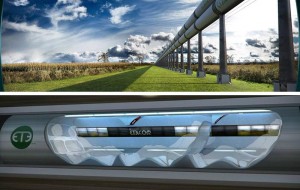
Rendering of the Hyperloop
Magnificent in many ways! Elon Musk, the South African born entrepreneur, inventor, businessman, “magnate,” recently blogged his idea of superfast and effective mass transportation between Los Angeles and San Francisco. The Hyperloop would take you point-to-point in 30 minutes, with tickets less than airline fares.
Musk is known for big ideas: The 42-year old cofounded PayPal and sold the company to eBay. He founded SpaceX which in May 2012 became the first commercial company to launch and dock a vehicle to the International Space Station. He co-founded Tesla cars. Days ago, Tesla’s sedan was rated the safest car sold. Musk continues to serve as Chairman of SolarCity, run by his cousin Lyndon Rive.
Musk has been outspoken about California’s high speed rail program with a completion date of 2029 and a cost over $100 billion. “It’s too expensive, too slow, and too impractical.” The project is also shrouded in a “horrendous lands rights mess.” His system is four times as fast at a fraction of the cost, following the “drab but direct” Interstate 5 corridor.
The Hyperloop is solar-powered, and super-fast. It uses aluminum pods that carry passengers travelling up to 800 miles per hour inside steel tubes. The tubes run side-by-side mounted on columns every 50 – 100 yards, closing the loop at each end. When operating, the distance between pods would be about five miles, thus Musk suggests that there would be up to 70 pods running between Los Angeles and San Francisco that leave every thirty seconds. And unlike air travel, it would be a smooth ride, no lateral movement or turbulence at all.
Musk suggests that the pods could also be designed to carry cars. He estimates the total system cost to be about $6 billion; $10 billion for the car-capable version.
White House Solar

President Carter with solar panels at the White House.
In 1979 President Jimmy Carter installed solar thermal panels at the residence at the White House. In 1986, and to the dismay of renewable advocates, they were taken down when Ronald Reagan’s Chief of Staff considered them “a joke.” Funny, for years since the panels have been producing free hot water for the Unity College dining hall in Maine.
Now solar is back on Pennsylvania Avenue: New American-made panels were installed earlier this month allowing the President to “walk-the-talk” given his order for 20% of all federal government electricity use to come from renewable resources.
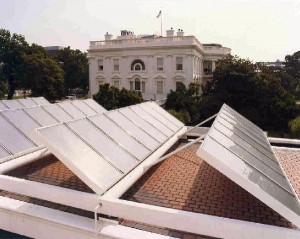
New solar thermal panels installed this year
The founder and head of 350.0RG, Bill McKibben, deserves great credit. He initiated a petition to re-install solar on the White House three years ago. With a group of Unity College students, he took back one of the original panels back to the White House with a petition signed by 50,000 people.
Secretary of Energy Chui promised in 2010 to re-install the solar panels. Finally that promise has been fulfilled. McKibben noted that, “Once again the nation’s most powerful address will be drawing some of that power from the sun.”
Trash Power
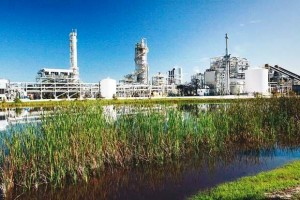
Cellulosic ethanol plant in Vero Beach, Florida
A New York Times article discusses the “undisputable elegance” of turning trash into gas. Pipe dream or magnificent biofuel?
A commercial-scale project in Vero Beach, Florida has produced the nation’s first cellulosic ethanol. This is a major step in the great promise of being able to create fuels from trash, steering clear of the fuels versus food aspects of ethanol production. Most ethanol here-to-date has come from corn or soy.
The Vero Beach cellulosic ethanol plant uses a hybrid process gasification and fermentation technology to convert wood scraps, grass clippings, and other waste materials into transportation fuels as well as energy for heat and power. INEOS Bio and New Planet Energy combined to develop the Indian River BioEnergy Center there.
The plant will have an annual output of 8 million gallons of cellulosic ethanol per year, as well as 6 MW of renewable power, enough to run the entire facility and provide excess power to the grid. The $130 million project was supported by a $50 million grant from U.S. Department of Energy. The plant employed 400 during construction, and is now operated by 65 FTE.
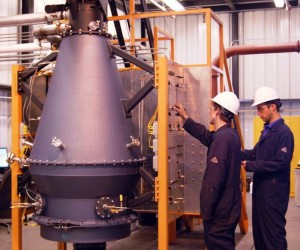
FastOx gasifier in operation
In related news, the Department of Defense has acquired its first Waste to Energy (WTE) technology for $3 million, Sierra Energy’s FastOx system, a technology that could revolutionize waste management particularly in wartime. The California Energy Commission also provided $5 million to Sierra Energy for development of its gasification system.
The FastOx gasifier is about the size of a shower stall. It’s actually a modified blast furnace, inspired by the experience of one of its inventors, a former Kaiser Steel employee. When closing the Fontana plant in 1983, he was told by management to throw combustion debris in the gasifier. That’s what gave him the idea. The FastOx adjusts the inputs, and can gasify everything from wood chips to sewage.
Inside the shower stall is a chemical reaction that heats the waste material to extreme temperatures without combustion. The outputs, hydrogen and carbon monoxide are syngas… which can be burned to generate electricity, or modified into ethanol or diesel fuel.
